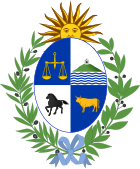Departments of Uruguay
| Departments of Uruguay | |
|---|---|
 | |
| Category | Unitary state |
| Location | Eastern Republic of Uruguay |
| Number | 19 departments |
 |
|---|
|
|
Uruguay consists of 19 departments. Each department has a legislature called a Departmental Board. The mayor of the department's capital city also serves as the department's chief executive.
History
The first division of the Republic in six departments happened on 27 January 1816. In February of the same year, two more departments were formed, and in 1828 one more was added. When the First Constitution was signed in 1830, there were nine departments. These were the departments of Montevideo, Maldonado, Canelones, San José, Colonia, Soriano, Paysandú, Durazno and Cerro Largo. At that time, the department of Paysandú occupied all the territory north of the Río Negro, which included the actual departments of Artigas, Rivera, Tacuarembó, Salto, Paysandú and Río Negro.
On 17 June 1837 a new division of Uruguay was made and this northern territory was divided in three parts by the creation of the departments of Salto and Tacuarembó. At the same time the department of Minas (which was eventually renamed to Lavalleja) was created out of parts of Cerro Largo and Maldonado. Then in 1856 the department of Florida was created and on 7 July 1880 the department of Río Negro was split from Paysandú and the department of Rocha was split from Maldonado. In 1884 the department of Treinta y Tres was formed from parts of Cerro Largo and Minas, while also the department of Artigas was split from Salto, and in the same year the department of Rivera was split from Tacuarembó. Finally in the end of 1885 the department of Flores was split from San José.
 |
 |
 |
 |
 |
| Series of maps showing the gradual formation of the actual 19 departments of Uruguay. | ||||
List of departments
| Flag | Department | ISO 3166-2 code |
Formation | Area (km²) |
Population (2011) |
Density (/km²) |
Capital |
|---|---|---|---|---|---|---|---|
| Artigas | UY-AR | 1884 (from Salto) |
11,928 | 73,378 | 6.15 | Artigas | |
| Canelones | UY-CA | 1816 (as Villa de Guadalupe) |
4,536 | 520,187 | 114.68 | Canelones | |
| File:Banderadecerrolargo.jpg | Cerro Largo | UY-CL | 1821 | 13,648 | 84,698 | 6.21 | Melo |
| Colonia | UY-CO | 1816 | 6,106 | 123,203 | 20.18 | Colonia del Sacramento | |
| Durazno | UY-DU | 1822 (as Entre Ríos Yí y Negro) |
11,643 | 57,088 | 4.90 | Durazno | |
| Flores | UY-FS | 1885 (from San José) |
5,144 | 25,050 | 4.87 | Trinidad | |
| Florida | UY-FD | 1856 (from San José) |
10,417 | 67,048 | 6.44 | Florida | |
| Lavalleja | UY-LA | 1837 (as Minas) |
10,016 | 58,815 | 5.87 | Minas | |
| Maldonado | UY-MA | 1816 (as San Fernando de Maldonado) |
4,793 | 164,300 | 34.28 | Maldonado | |
| Montevideo | UY-MO | 1816 | 530 | 1,319,108 | 2,489 | Montevideo | |
| Paysandú | UY-PA | 1820 | 13,922 | 113,124 | 8.13 | Paysandú | |
| Río Negro | UY-RN | 1868 (from Paysandú) |
9,282 | 54,765 | 5.90 | Fray Bentos | |
| Rivera | UY-RV | 1884 (as Tacuarembó) |
9,370 | 103,493 | 11.04 | Rivera | |
| Rocha | UY-RO | 1880 (from Maldonado) |
10,551 | 68,088 | 6.45 | Rocha | |
| Salto | UY-SA | 1837 | 14,163 | 124,878 | 8.82 | Salto | |
| San José | UY-SJ | 1816 | 4,992 | 108,309 | 21.70 | San José de Mayo | |
| Soriano | UY-SO | 1816 (as Santo Domingo Soriano) |
9,008 | 82,595 | 9.17 | Mercedes | |
| Tacuarembó | UY-TA | 1837 | 15,438 | 90,053 | 5.83 | Tacuarembó | |
| Treinta y Tres | UY-TT | 1884 (from Cerro Largo and Lavalleja) |
9,676 | 48,134 | 4.97 | Treinta y Tres |
Municipalities
Since 2009 (Law No. 18567 of 13 September 2009),[1] the Uruguayan departments have been subdivided into municipalities. As Uruguay is a very small country (3 million inhabitants, of which roughly one-half lives in the national capital), this system has been widely criticized as a waste of resources. Nevertheless, in the municipal elections of 2010 the local authorities were elected and they assumed office months later. Currently there are 89 municipalities scattered all over the country.


